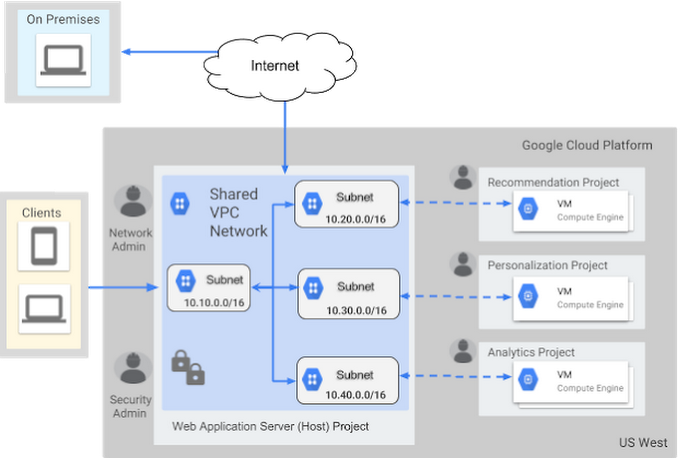Getting started with Shared VPC
Neha Pattan
Staff Software Engineer
Large organizations with multiple cloud projects value the ability to share physical resources, while maintaining logical separation between groups or departments. At Google Cloud Next '17, we announced Shared VPC, which allows you to configure and centrally manage one or more virtual networks across multiple projects in your Organization, the top level Cloud Identity Access Management (Cloud IAM) resource in the Google Cloud Platform (GCP) cloud resource hierarchy.
With Shared VPC, you can centrally manage the creation of routes, firewalls, subnet IP ranges, VPN connections, etc. for the entire organization, and at the same time allow developers to own billing, quotas, IAM permissions and autonomously operate their development projects. Shared VPC is now generally available, so let’s look at how it works and how best to configure it.
How does Shared VPC work?
We implemented Shared VPC entirely in the management control plane, transparent to the data plane of the virtual network. In the control plane, the centrally managed project is enabled as a host project, allowing it to contain one or more shared virtual networks. After configuring the necessary Cloud IAM permissions, you can then create virtual machines in shared virtual networks, by linking one or more service projects to the host project. The advantage of sharing virtual networks in this way is being able to control access to critical network resources such as firewalls and centrally manage them with less overhead.Further, with shared virtual networks, virtual machines benefit from the same network throughput caps and VM-to-VM latency as when they're not on shared networks. This is also the case for VM-to-VPN and load balancer-to-VM communication.
To illustrate, consider a single externally facing web application server that uses services such as personalization, recommendation and analytics, all internally available, but built by different development teams.


Let’s look at the recommended patterns when designing such a virtual network in your organization.
Shared VPC administrator role
The network administrator of the shared host project should also have the XPN administrator role in the organization. This allows a single central group to configure new service projects that attach to the shared VPC host project, while also allowing them to set up individual subnetworks in the shared network and configure IP ranges, for use by administrators of specific service projects. Typically, these administrators would have the InstanceAdmin role on the service project.Subnetworks USE permission
When connecting a service project to the shared network, we recommend you grant the service project administrators compute.subnetworks.use permission (through the NetworkUser role) on one (or more) subnetwork(s) per region, such that the subnetwork(s) are used by a single service project.This will help ensure cleaner separation of usage of subnetworks by different teams in your organization. In the future, you may choose to associate specific network policies for each subnetwork based on which service project is using it.
Subnetwork IP ranges
When configuring subnetwork IP ranges in the same or different regions, allow sufficient IP space between subnetworks for future growth. GCP allows you to expand an existing subnetwork without affecting IP addresses owned by existing VMs in the virtual network and with zero downtime.Shared VPC and folders
When using folders to manage projects created in your organization, place all host and service projects for a given shared VPC setup within the same folder. The parent folder of the host project should be in the parent hierarchy of the service projects, so that the parent folder of the host project contains all the projects in the shared VPC setup. When associating service projects with a host project, ensure that these projects will not move to other folders in the future, while still being linked to the host project.
Control external access
In order to control and restrict which VMs can have public IPs and thus access to the internet, you can now set up an organization policy that disables external IP access for VMs. Do this only for projects that should have only internal access, e.g. the personalization, recommendation and analytics services in the example above.As you can see, Shared VPC is a powerful tool that can make GCP more flexible and manageable for your organization. To learn more about Shared VPC, check out the documentation.


